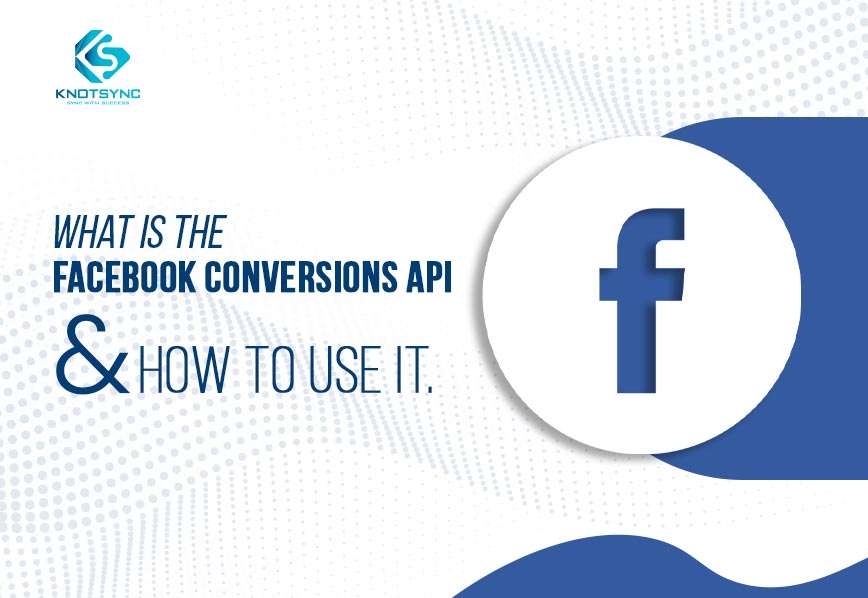If you want to market your business on Facebook, you must know about Facebook ad targeting. For that, Facebook Conversions API is important. But what is it? Let us find out.
What is Facebook Conversions API?
Earlier Facebook used Facebook pixel to track user data. It helped businesses know how users interacted with their business. But Facebook pixel was a browser-based tool, meaning that ad blockers and cookie blockers limited the amount of data the pixel received. On top of that, Apple’s iOS 14 update further restricted the use of cookies for tracking on all Apple mobile devices.
That’s when Facebook introduced another tool in its data toolkit called Facebook Conversions API. The tool makes use of users’ website servers to track conversions. One must not replace it with a Facebook pixel. Instead, use it in collaboration with Facebook pixel to capture more data and improve the accuracy of Facebook ad targeting.
What Can You Track with Facebook Conversions API?
One can track the following data with Facebook Conversions API:
Web conversions: How many people signed up for the campaign and the sales.
Post-conversion events: How many people got approvals for a loan.
Page visits: How many people visit your page.
Other than the above data that Facebook Conversions API tracks, the tool also offers data required for:
- Ad reporting
- Targeting ad
- Audience insights
- Dynamic ads
- Conversion optimization
Why Set Up Facebook Conversions API?
Read on if you are already using Facebook pixel and wondering why you should set up Facebook Conversions API.
Fills the Gaps Left by Facebook Pixel, Improving Measurement
We’ve already established that pixel is not able to track data accurately. To get complete data for ad optimization and improve your Facebook tracking accuracy, Facebook Conversions API is a must. It will help you measure the ad performance of your customer’s whole journey from discovery to conversion.
Optimize Facebook Ads Targeting
When you use Facebook pixel alone, you miss out on getting data of Apple mobile users. They might be your prospects who are likely to convert and get your product or service. But with Facebook Conversions API, you can effectively track users to your site. The more effective the tracking, the better the conversion will be.
Reduction in the Cost Per Action of Your Facebook Ads
When you get more accurate data with conversions API compared to Facebook Pixel, the Facebook algorithm also gets fed with rich data that is then used for Facebook ad targeting. As a result, the Facebook delivery system decreases our cost per action, and the ads are shown to your targeted potential customers, who are more likely to convert.
Optimize Ads for Actions that Occur Later in the Customer’s Journey
With Conversions API, you will get to optimize ads for events that take place later on in during the buyers’ journey. For example, loan approval after applying for a loan, subscriptions after the purchase has been made, etc. The information collected will then be used to show your ads to people you are more likely to convert and be profitable for your business.
Conversion API V/s Facebook Pixel 250
The major difference between the two is that while conversion API is a server-side tool, the Facebook pixel is a browser-side tool. It means that conversion API helps track conversions through the website’s server, whereas the same is done through the user’s browser in Facebook pixel. When it comes to using them for ad targeting, it’s not like you can use either of them. Instead, use them both together.
| Conversions API
|
Facebook Pixel
|
| Track conversions via the website’s server. | Track conversions via the user’s browser. |
| Does not rely on cookies. | Relies on cookies. |
| ———— | Lose data when the connection is bad |
| Data is not affected by ad blockers, browser loading errors, and connectivity issues. | Data gets affected by ad blockers, browser loading errors, and connectivity issues. |
How to Set Up Conversion API?
One can set up Facebook Conversions API using two ways: through partner integration setup and manual implementation. Depending on the platforms you use and how much technical help you can get from within your business, you can choose any one of them.
Before we find out how to set up Facebook Conversions API using either way, do not forget to have an already functioning Facebook pixel and Facebook Business Manager.
Setting Up Conversions API with Partner Integration Setup
With partner integration setup, you don’t need to know any code. You can set up Conversions API without the help of a developer. But there’s a catch. Your website needs to be hosted on one of Facebook’s partner platforms to use this method.
We helped our client PrintMynd, which partners with WooCommerce, set up Conversions API. Here’s how we helped them implement it through partner integration setup.
Step 1: Go to your Facebook Events Manager. In the Data Sources tab, choose your pixel. Then click on Settings option that appears on the extreme right side of the top menu.

Step 2: In the Conversions API section, under the Set up through a partner integration, click on Choose a Partner tab.

Step 3: Select the partner platform that you use. In our client’s case, it was WooCommerce. Once you choose your provider, you will be redirected to the setup instructions of your integration partner.
After that, you can follow the instructions and complete the integration process. Did you know how reduce your Facebook ads cost.
Setting Up Conversions API by Manual Implementation
You may choose not to use partner integration for integrating Conversions API. In that case, you can set it up manually by going to Events Manager and creating your own set of instructions for developers.
With this method, you will get to track events and parameters that the pixel cannot track. But the downside is that to integrate Conversions API manually, you need to have access to your server codebase and get the developer’s help.
Step 1: Go to your Facebook Events Manager. In the Data Sources tab, choose the pixel you want to use to integrate the Conversions API.
Step 2: Go to Add Events and choose Using the Conversions API.
Step 3: Click Install code manually, go through the overview and click Continue.
Step 4: Decide which events you want to track. Facebook provides event recommendations. You can also check that to decide. Once done, click Continue.
Step 5: Choose the parameters for each event and click Continue. Then click on Confirm Setup and Send Instructions.
Step 6: Put in your developer’s email address and click Send. Get a copy of the mail by checking the box that says Send me a copy of this email.
Now the rest is up to your developer. They will complete the setup based on the events and parameters you set.
Final Words
Setting up Conversions API is a great way to optimize ad targeting, measure results, lower cost per action, and get additional insights into the audience who interacts with your business. However, remember to use Conversions API along with Facebook Pixel to maximize the effectiveness of your ad campaigns. Contact our digital marketing experts to get help with facebook ads.




